7 Tips for Surf Fishing with a Texas Rig
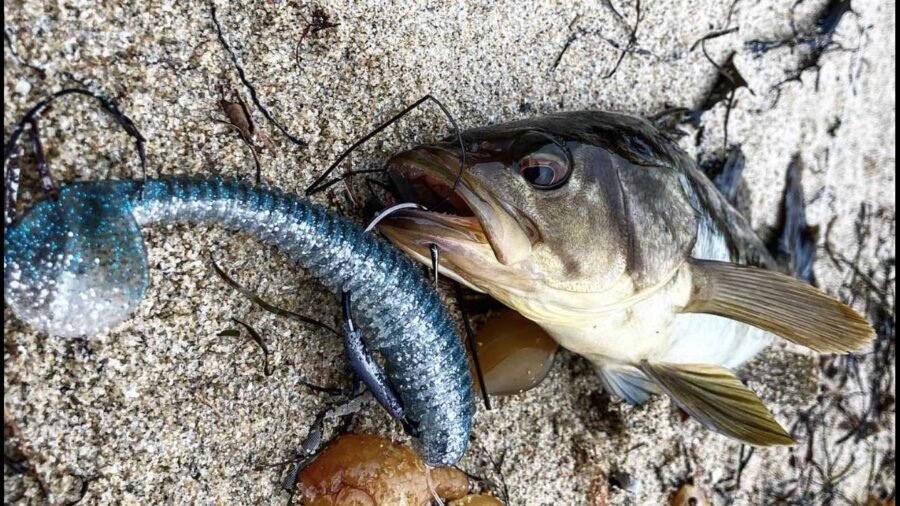
Surf fishing with a Texas rig is a method many surf anglers use when fishing with artificials. The main benefit in using this rig is that it offers arguably the most “weedless” option for surf fishermen who like to fish with lures. It’s one of the most trusted rigs for fishing in lakes, bays and even the surf. Let’s talk about why you should use a Texas rig and how to fish it to its fullest potential.
Navigate this article with the internal links below:
- Choose the Best Swimbait for Your Texas Rig
- Choose the Best Hook for Your Texas Rig
- How to Retrieve
- Setting the Hook
- Should You Pin Your Bullet Weight?
- Picking a Rod
- Picking a Reel
Why Use a Texas Rig for Surf Fishing?
Weedless and Minimal Snags
It’s no secret that the Texas rig offers the most weedless presentation when fishing with lures. When rigged properly, the point of the hook is tucked away in the top groove of your swimbait (as shown below). This keeps kelp from accumulating on your lure, allowing your lure to swim naturally and through areas with dense vegetation. It also helps to prevent snags on rocks and reefs.
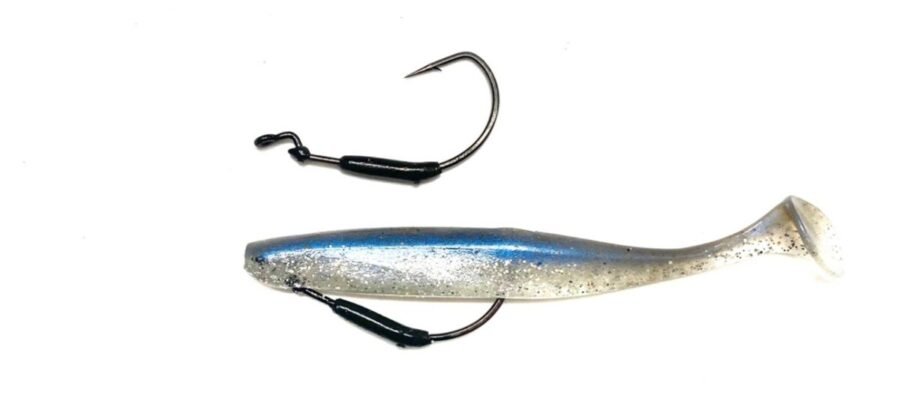
Changing the Weight of Your Lure: Customizability of Your Hook/Lure Combo
Jigheads come in various sizes and weights, but those sizes usually correlate with the weights so you can’t often find a 4/0 jighead that’s more than half an ounce. This is where the Texas rig allows you to customize your lure weight.
With a Texas rig, you can use take that 4.75-inch swimbait that fit perfectly on a 4/0 hook and you can add a 1/2 oz bullet weight and throw the swimbait on a weighted hook like the Mustad Weighted KVD Grip-Pin or the Owner Beast.
Now, let’s dive in to our 7 tips on using a Texas rig in the surf.
Choose the Best Swimbait for Texas Rig

The Catch Co BioSpawn ExoSwim Paddle Tail Swimbait is quickly becoming my favorite swimbait for Texas rig and all other styles of surf fishing with swimbaits. It’s durable, has great action, and it’s beefy shape draws in the larger predators like legal halibut, big calico bass and white seabass. I use the 4.75-inch BioSpawn with a 4/0 Mustad KVD Hook (referenced below).
My one and only complaint to date is that I wish they’d start making them with more glitter in their color options. Overall though, this is the best swimbait for Texas rig.
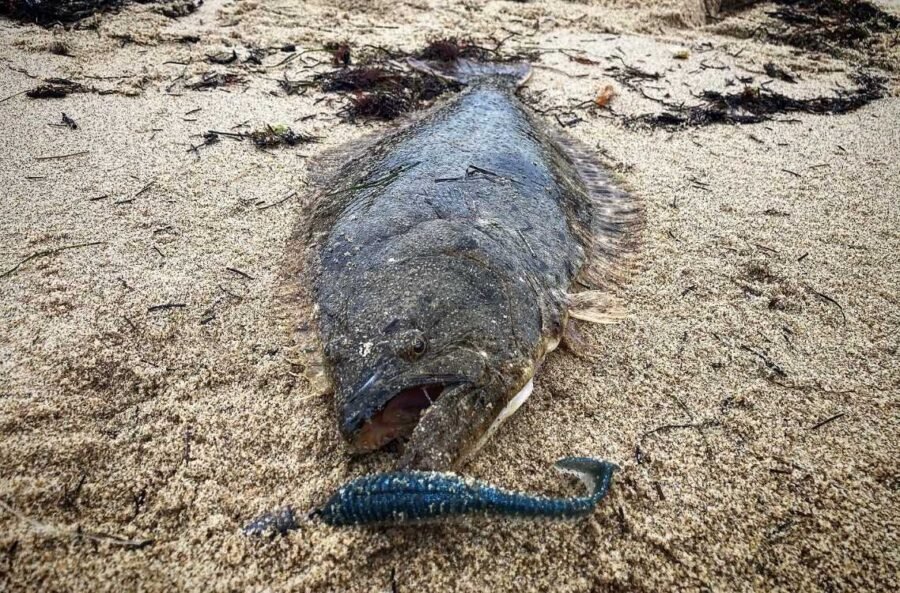
Choose the Best Hook for Texas Rig
Thus far, I’ve really enjoyed the Mustad Weighted KVD Grip-Pin swimbait hook. It’s strong, compact, sharp, and it’s perfectly shaped for the Texas rig. Another hook I’ve heard great things about is the Owner Beast Weighted Swimbait Hook. This hook features a twist lock.
How to Rig Up Your Texas Rig: Twistlock vs Traditional
There’s a major pro and a major con to using each of these. The twist lock allows you to up the weight on your hook as much as you want because you don’t have to thread the hook through your swimbait. That said, you won’t tear a big hole in your swimbait if you use a heavier hook with a swimbait that isn’t super elastic like the Z-Mans. But, while it allows you to use a heavier hook, I think the permanent gap between the bullet weight and the hook catches more kelp than the traditional swimbait hooks.
The traditional swimbait hooks allow you to rig them like I did in the image shown earlier (“How to Rig a Texas Rig”). You see how I almost hid the entire hook in the swimbait? This allows the bullet weight to hug the rubber as clean and as close as possible, making it tougher for seaweed, grass and other junk to accumulate on your lure.
My best advice is to try them both and figure out for yourself which one is right for you.

What Kind of Retrieve with a Texas Rig?
The speed and style of your retrieve will likely vary depending on the conditions, the terrain, and the weight of your rig as all of that will affect how quickly your lure falls in the water. The more you fish, the better “feel” you’ll have in terms of being able to envision where your lure is and how it’s moving.
Personally, I like a slow retrieve, steady at times and a few twitches at other times. I’ll try a few different types of retrieves until I start getting bites but almost always, I prefer slow/steady and slow with some twitches (to bounce it off the ground). The video below this next section shows the variance in my preferred retrieves.
Setting the Hook with a Texas Rig
One of the toughest things to figure out is when to set the hook. It’s a challenge deciphering whether a fish has fully grabbed the hook or only bumped your bait, or whether it was even a fish at all! Rocks, reefs, kelp and other structure can confuse even the most experienced of anglers.
Sand Crabs and Carolina Rig
Being a surf fishermen before anything else (very minimal experience outside of surf fishing), I’m convinced that with most species of fish we catch in the surf while using sand crabs for surf fishing, you can’t set the hook immediately.
You can NOT set the hook when you feel, “tap… … tap-tap… … tap”. You can only set the hook when you feel “tap-tap-tap-tap-tap” and your rod loads up and you feel the weight of the fish.
Jerkbaits
Prior to fishing swimbaits, my lure fishing experience was again, in the surf but with jerkbaits. With jerkbaits, I never set the hook. All the treble hooks naturally hook the fish and as long as you continue retrieving, you’ll get as good a hook set as you can.
Texas Rig and Other Swimbaits
Setting the hook with a Texas rig in the surf is an art. Go back to the video I made where I Hooked 10 Halibut in Under 3 Hours, and you’ll see how much of a learning process surf fishing with swimbaits has been. The video on surf fishing for white seabass (shown above) is a much better example of how to successfully set the hook with a Texas rig.
I see it as similar, but not identical to surf fishing with a Carolina rig and sand crabs. Many experienced anglers I fish with swear by setting the hook upon the first indication of a bite. I’m a bit different. I think there’s a subtle difference between a “take” and a “tap” and I never want to set the hook too early and risk missing and/or spooking the fish.
If I just feel a couple taps, it could be a fish bumping my bait. It could also just be a rock or some other form of structure that my weight or lure bumped. I will continue retrieving normally, sometimes offering a pause if I think my lure can fall down into the water column a little more. When I feel more than two strong taps in a row or if my lure stops altogether, I will proceed to set the hook.
Should You Pin the Bullet Weight or Let it Slide?
The term “pinning your weight” refers to when anglers purposely jam something (usually a toothpick or a rubber stop) between their leader and the remaining room inside the hole of the bullet weight. They do this to stop the bullet weight from sliding away from the lure while retrieving. The reasoning here is to keep presentation uniform, to keep weeds from filling the gap, and to keep the lure and the weight falling and rising at the same level and rate.
I have yet to use any “jamming” or “pinning” technique with a Texas rig as I don’t like the idea of creating unnecessary and unnatural resistance that might lead to a frayed or snapped line. I see the benefits, but I’ve also had no issues with letting it slide.
Best Rod for Texas Rig in the Surf
Okuma SST-S-902Ha SST Cork Grip Spinning Rod

The Okuma SST (recommended model # listed above) is best in the following specs for surf fishing with the Texas rig.
- Length: 9′
- Power: Heavy (H)
- Taper (Action): Moderate-Fast (MF)
- Lure Weight: 10-30lbs
- Line Weight: 1/2 – 2oz
- Number of Pieces: 2
- Number of Guides: 8+1
Best Reel for Surf Fishing with a Texas Rig
Penn Spinfisher VI 4500

Putting It All Together
- Rod: Okuma SST-S-902HA – 1/2-2oz | 10-30lb | 9ft | H | MF
- Reel: Penn Spinfisher VI (3500 or 4500)
- Main Line: 30-pound braid
- Leader Line: 30-pound mono
- Lure Options:
- Lucky Craft FM 110 (jerkbait)
- Keitech Fat Swing Impact (4.8″) | Warbaits 0.5-ounce Weedless Jighead
- BioSpawn ExoSwim (4.75″) | Mustad KVD Grip Pin Swimbait Hook (5/0 | 1/8oz) (T Rigged)
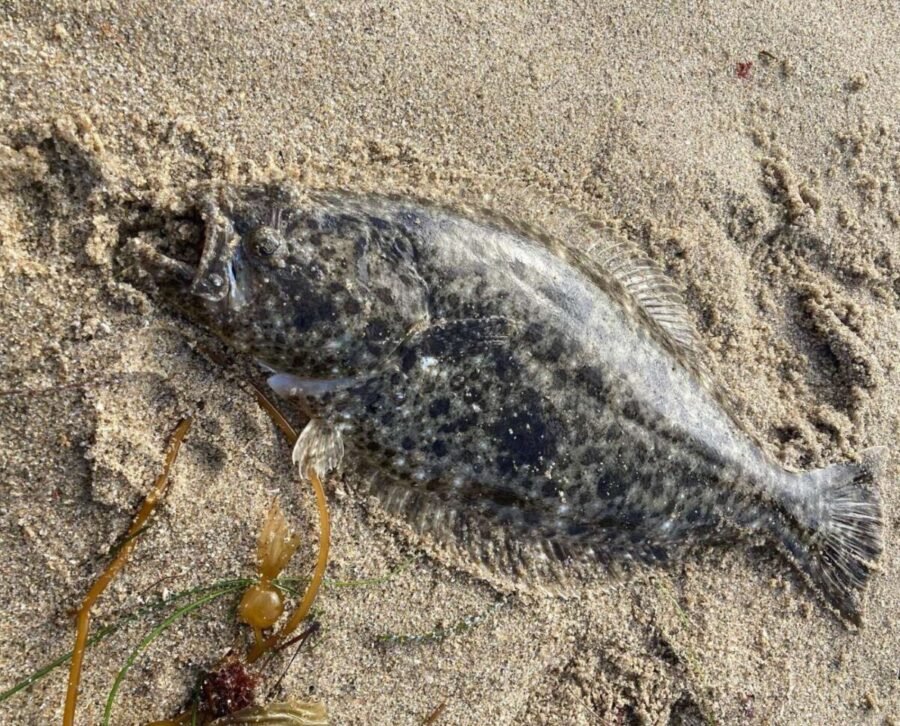
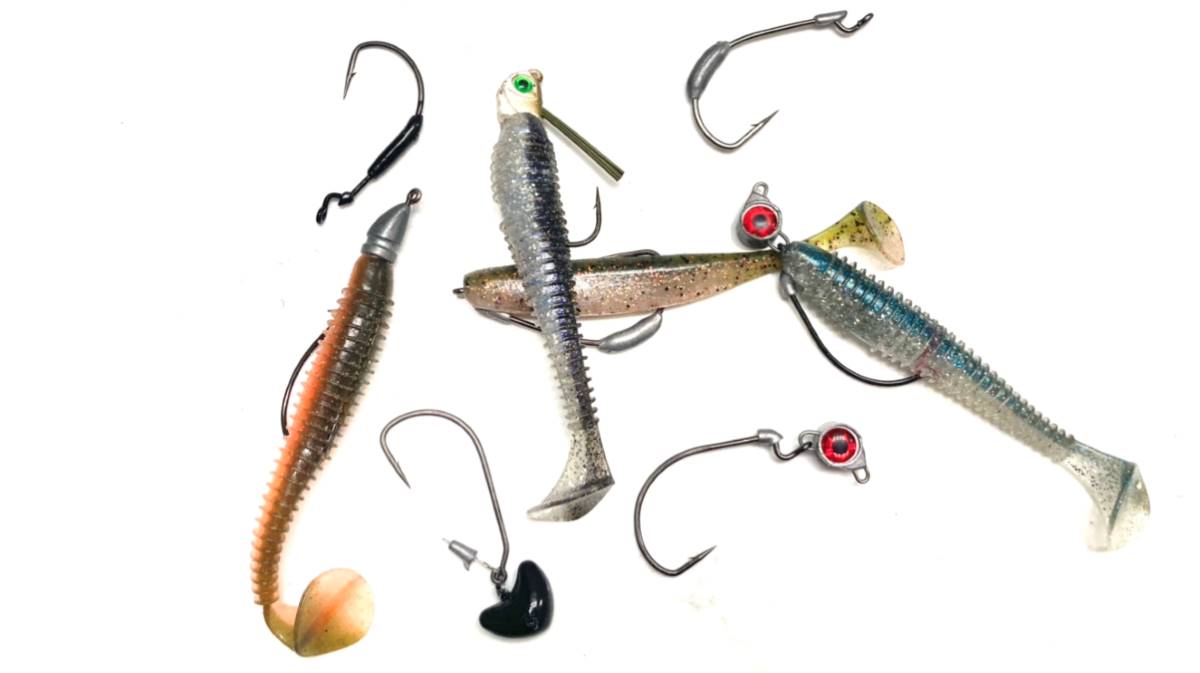

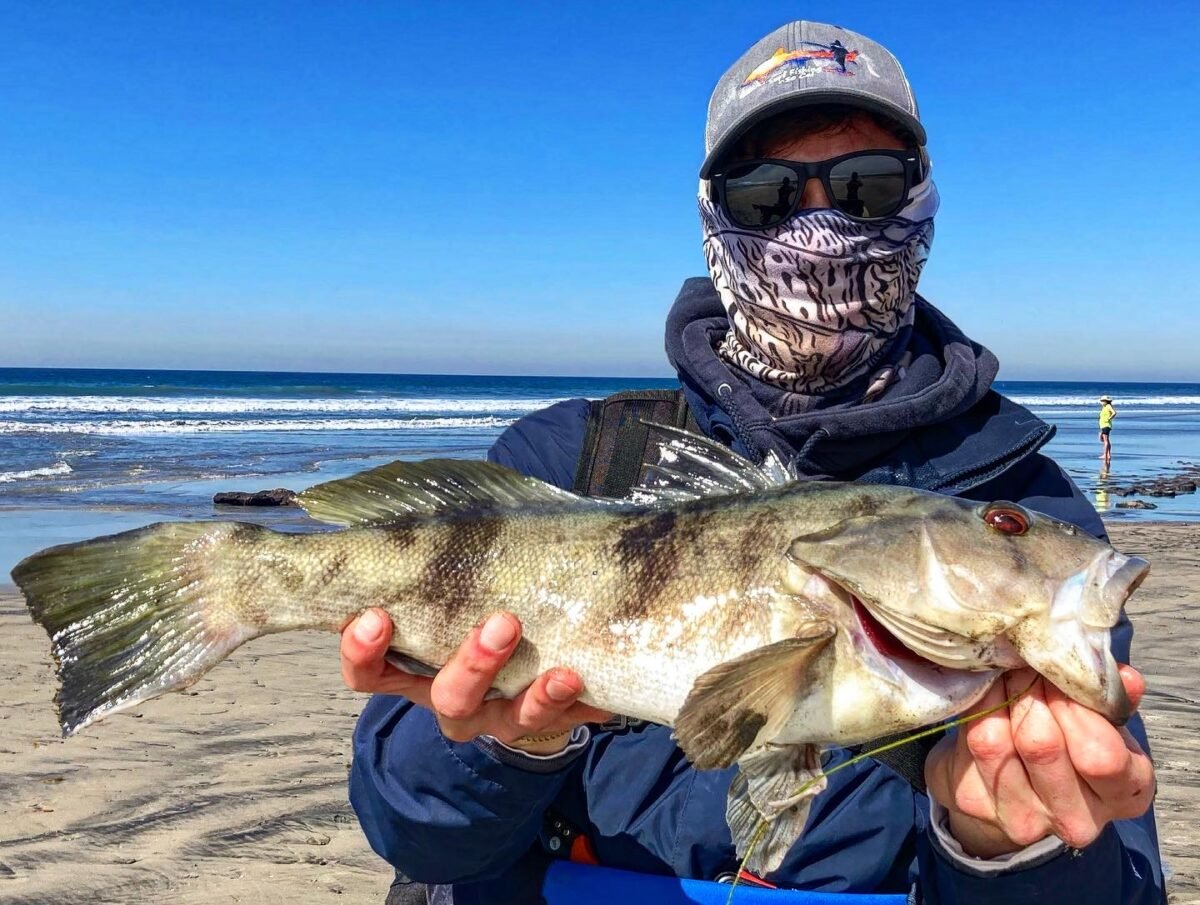
Hi,
Really enjoy your articles. I have learned a lot about surf fishing. I have a question tho and maybe you could turn it into an small article for us who are getting their feet wet in this field.
You often have different line setups i.e 30lb braid w a 50lb mono leader etc.
While “I think” I understand the philosophy, there’s still a lot I don’t especially when a mix of mono main and fluro leader.
Could one week article go deeper into this subject articulating the philosophy of why these line combinations are used and what the end result aim is such as maybe how it affects the swim bait or live bait presentation to the fish.
Thanks so much
Albert Sebastian
Thanks for reaching out with a question, Albert! I’ve added this topic to my “to-write” list so hopefully I can get an article out soon.